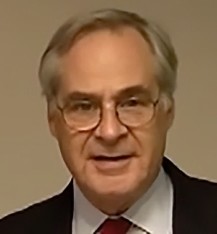Reform the K-12 Government- School Monopoly: Economics and Facts
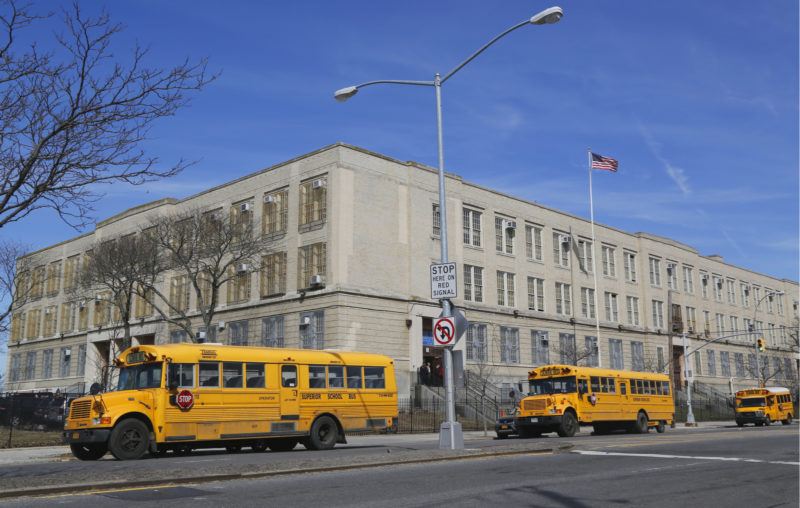
Since when are we denied choice in our consumption decisions? That certainly is not the case in free markets. Only when there is a monopoly are we denied choice. The negative consequences of that are well known, and there is a long tradition in the United States of monitoring and breaking up monopolies. At a later point, there will be discussion about how public education monopolies came about but, suffice it to say, there is no longer an economic justification for them. Monopolies produce goods and services at a higher price and a lower quality than would be obtained in a competitive market. That is certainly the case with public education.
The purpose of this study is to report on data and facts gathered about the relative costs and benefits of public school education versus the alternatives. Data was found that we believe has not been analyzed before, despite their existence in databases available from reliable US government agencies. When discussing school costs, the data typically evaluated is from nonprofit organizations. Their reports are based on data given to them by participating schools or derived from sources that the uncritical mind naively believes are useful, as is, for analytically based decision-making.
Human progress and the development of human capital go hand in hand. Formal education is the crucial beginning of that development. This leads to more productive and innovative citizens, which, in turn, leads to greater economic growth and social success. This chain of success begins with the education of the young. Naturally, society should be interested in data about the costs and outcomes of different approaches to education, namely public versus private schools, and how this data should affect our choices and behavior.
It is not easy to acquire comprehensive and consistent data over time. In this report new ground is broken as a result of finding data from non-conventional but reliable government data agency sources. This data breakthrough allows a long-term analysis of trends and levels in the relative cost, per pupil, for public and private education at the K-12 level. In addition, though initially difficult to obtain, we succeeded in obtaining to a limited degree standardized testing results for public and private schools.
This study obtained expenditure data buried in the details of the National Income and Product Accounts of the US, more familiarly known as the NIPA accounts. The data is constructed from public and nonpublic sources by the Bureau of Economic Analysis (BEA) at the US Department of Commerce – the same agency that calculates the data for Gross Domestic Product (GDP). Enrollment statistics were obtained from the US Census Department.
For comparison purposes we also looked at expenditure and enrollment data gathered by the National Center for Education Statistics (NCES). More on that later.
Per Student Cost of Public and Private Education
This study found that currently (as of 2018), a public school education in the US costs 89% more than private education; that is, $14,653 for a public school and $7,736 for a private education. The high relative cost of public school education has persisted since the earliest period for which the data has been collected – 1965 (Chart 1a). This is a rather startling finding and contrary to the understanding public officials have generally led us to believe about the cost of public and private education.
Private education is significantly less expensive. However, its cost has been rising at a somewhat more rapid rate then public school education. In the 1960s, private education was 35-40% of the cost of public schools. Today, it is slightly more than half the cost.
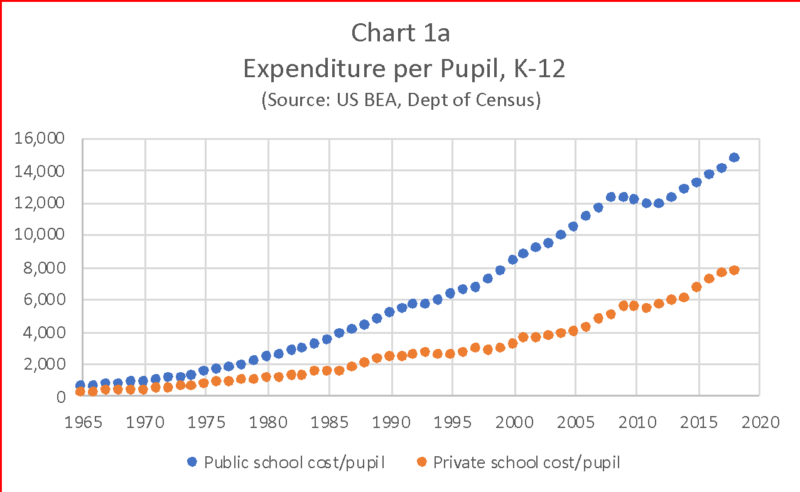
These are averages computed from US Government data. As averages they obscure the fact that the costs vary widely across the country for both public and private education. Some public schools are very expensive and exclusive to the residents of towns and cities that are very prosperous and collectively agree to accept high property and real estate taxes to finance that outcome. Other locals are not as well endowed, despite supplemental funds transferred from state educational funds. At the same time the cost of private education is also highly variable ranging from exclusive boarding schools and prep schools to neighborhood charter and parochial schools, and homeschooling.
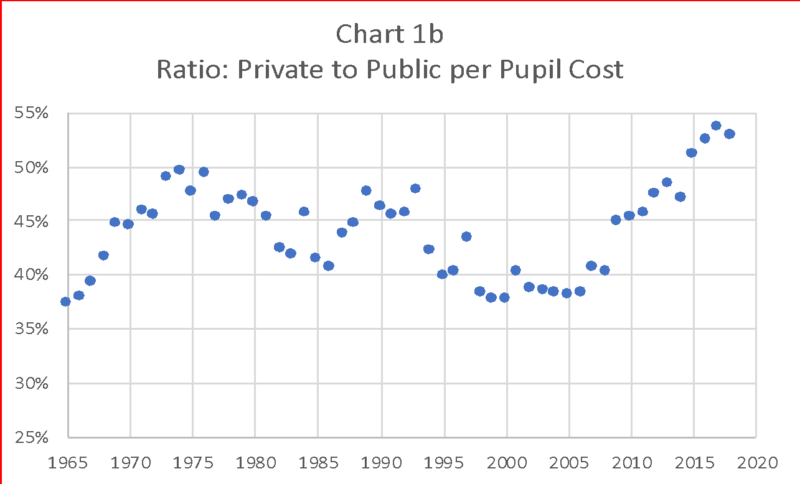
The NCES estimates the 2018 per pupil cost for public school education at 10% less than the BEA’s estimate at $13,220 compared to the $14,643 mentioned above. The overall trend and level of NCES’s cost calculations for public schools are broadly similar to our BEA-derived estimates. Both suffer from the omission of the true actuarial cost of the benefit package school system employees receive in their retirement years. The data we are given only include the annual contribution to those benefit funds. However, as is well known from other studies, state and local benefit plans are hugely underfunded and the shortfall is expensed annually from the general budget. It has been estimated that this omission, if properly accounted for, would likely add 15% to the per pupil cost of public education. Total compensation in the school system comes to 75% of the total school budget.
Setting aside errors and differences in the cost estimates of public school education, the real contribution to useful knowledge of the data provided in this study is a more accurate estimate of the cost of private education using BEA data rather than the NCES data. The NCES looks only at “posted” tuition charges for a sample of private schools (see next section for more details). In 2011, the last year the NCES provided a cost estimate, the BEA cost per pupil came in at half of the NCES estimate at $5,400 vs $10,700.
There is wide variation between school districts. There are approximately 14,000 local school agencies in the US. Public sources do not provide data at that fine a level of detail. To get some feel for the variation of costs, state level data was used. According to the NCES, the cost per pupil varies between $7,000 and $23,000, suggesting a variance of +/- 50% around the national average. There is little doubt the variance is even greater at the district and county level, given the very high real estate taxes paid by residents in the toniest zip codes that provide near exclusive private school levels of education quality and cost.
What is Private Education?
To better understand these startling cost differences, one must understand what is meant by private education; that is, what is included in the universe of private education providers, outside of the public school system. The parents of the students who are the consumers of education are clever and determined to craft and negotiate affordable quality education. Many types of private education solutions have emerged. At one end there is homeschooling, which in total accounts for about 10% of the private education population. A variant called ‘school pods’ have emerged in recent years that pools homeschooling on the internet. At the other end of the spectrum, there are expensive and exclusive prep schools. They, too, represent about 10% of all private education enrollment. In between are a wide variety of parochial and non-sectarian schools that operate on tight budgets.
Important to the understanding of the data, as it turns out, parents rarely pay the full posted tuition, even at the expensive prep schools. Our finding of $7,736 is half of the tuition schools post in their offering documents as stated by the NCES. Schools offer discounts, grants and scholarships. I have seen the books of one school that reveals a realized per pupil tuition that is about half the posted price. Homeschooling and school pods bring further economies of cost. One would not have an inkling of that from the standard data provided by the education industry.
What is Public School Education?
The quality and nature of public schools are not uniform across the country. In wealthy suburban areas, the community agrees to impose upon itself high real estate taxes in order to finance outstanding education. Even within urban areas, there are specialty schools that have competitive entry exams and often are organized toward a particular career path such as the arts or sciences. Every state government understands that there are unequal economic conditions across their state. To remedy the unequal impact that would have on local education quality, a portion of local real estate taxes are redistributed from richer to poorer districts to level the school funding to a fairer degree.
Is the Demand for Private Education Growing Rapidly?
Curiously, there appears to be virtually no growth in private education enrollments over the past 30 years whereas public school enrollments have grown. Homeschooling, almost invisible at the bottom of Chart 2, has grown somewhat. However, data for homeschooling is very scarce as there isn’t a large national constituency and data collecting organization. Of course, most of the data is delayed by 2 years, so there may be an uptick in private school demand once we get data for the most recent two years through 2020.
This lack of growth in private education is surprising given the reputation of better academic outcomes being realized. An obvious explanation for the absence of relative growth in private education, despite its low relative cost, is because the total cost of private education is in addition to the cost of public education. Everyone pays for the cost of public education, whether they have children of school age or not, whether they rent or own an apartment or own a house, and irrespective of whether they send their children to private school.
There are some interesting exceptions to how quasi-private school is priced, which would invite further study regarding the price elasticities of school demand. For example, homeschooling is a quasi-private education, yet the cost of homeschooling does not add significant additional costs. A homeschooled child is attached to a public school district and subject to their control. However, there are considerable indirect costs, namely the value of parental time devoted to teaching. Charter schools, as well, do not impose an additional cost burden on parents, as charter schools are generally operated within the public school system, often in the same building.
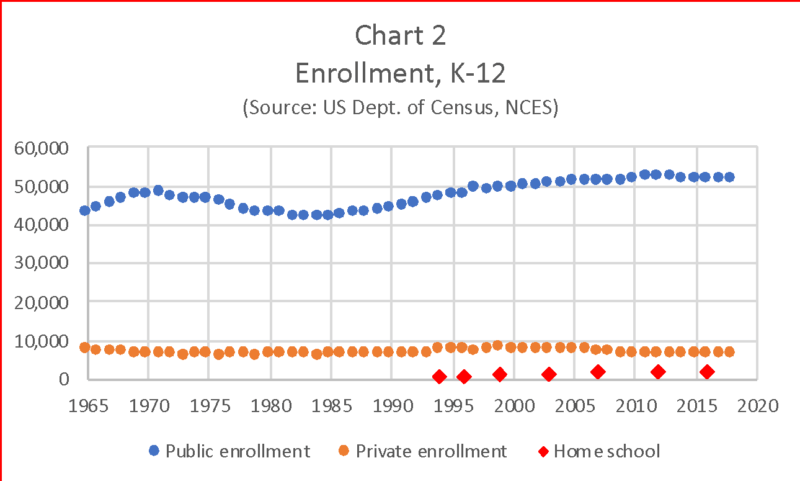
Are the Results of Public and Private Education Similar?
While the generally accepted knowledge is that private education produces better results than public school education, it is hard to find the data to make the case one way or the other. A search of publicly available data and analyses turned up three curiosities: (1) ACT or SAT results broken down by the type of educational institution the test taker goes to are not publicly available, unless you are lucky and found something that fell between the tracks; (2) studies of test results differences between public and privately schooled students mainly focus on finding social/demographic explanations, using longitudinal data (meaning cross-sections of time, not over time). The analyses try to normalize the results to explain why test results do not show improvement in public schools or are comparatively different from private schools; (3) no separate longitudinal or time series studies were found that explain trends and levels in test results for students receiving private education.
What has been found are overall national SAT results, which are shown in Chart 3. These results break out average scores for critical reading and mathematics. They are test results for all college-bound students regardless of the educational institution they were enrolled at. There is no need to cite the exact numbers. The overall results are well known. Critical reading results are in a down trend since 1966 and mathematics results have oscillated but are no better today than 50 years ago and are trending down since 2004.
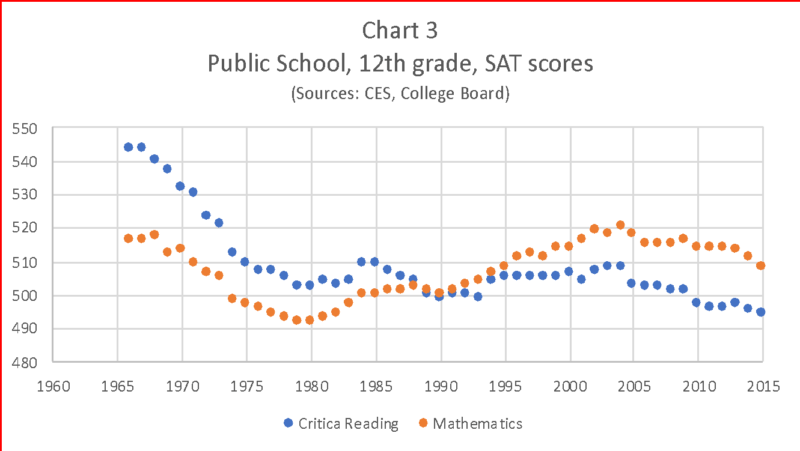
ACT is an alternative testing company. They use a different metric from the SAT. Their data is also publicly unavailable separated by public and private school students, but It was possible to ‘scrape’ off the internet a chart which displayed some data on test results by type of educational institution from a one-time study they published. We do not have the underlying data but have reproduced their chart as Chart 4. It shows the trends and levels in the composite ACT test results (meaning for math and reading combined) for the period 2001-2014, for private, public and homeschooled children.
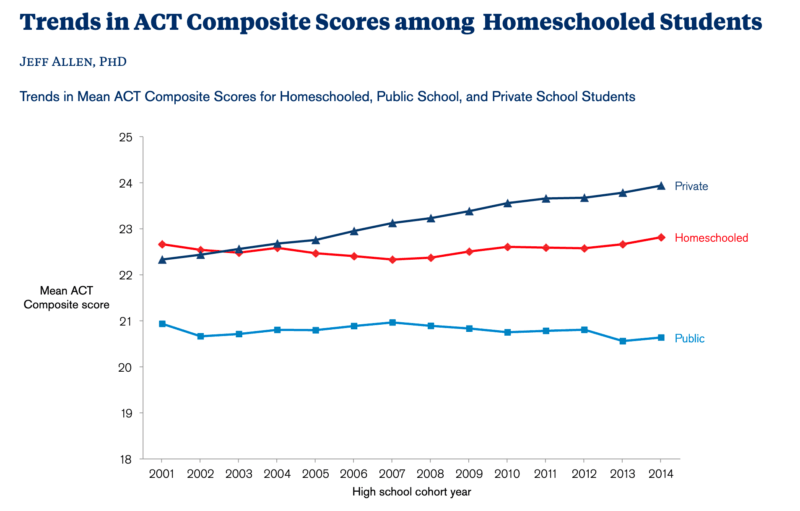
The results speak for themselves – private schools test at a significantly higher level than public schools, and the gap is widening. However, there is no question that public schools have a larger, more inclusive mandate to teach all children in the community, including those with disabilities, those where English is a second language, and the children from homes with chaotic domestic situations. Homeschooled children have the advantage of devoted parents who both choose to educate their children and are able to afford the time of at least one parent to do it. Private schools are more selective as to who they accept – unless they are specialized schools that work with certain handicaps such as blindness and hearing impairment – largely because they are generally not equipped to handle significant disabilities.
Logic for Monopolies Granted by the State
Consumers of any product know they get better outcomes, as measured by quality and price, if the product is offered in competitive markets. This is true even in markets that have only limited competition. Any competition is better than none. Just as that principle is true in the markets for cars and cafes, so it is true in the market for educational services.
The existence of competitive markets for education runs into some harsh realities, practical considerations and trade-offs in the US due to geography, economies of scale, social policy and getting agreement on basic standards and curriculum.
The provision of a “public good” of “free and equal” public education for all is a noble goal. It is not an easy one to fulfill given the dispersion and diversity of our geography and of our society. Whereas, in many other countries, education is controlled at the federal level, in the US it is delegated to the several states and locales to provide schools. A ragged system evolved inconsistently across the country. Inequities emerged revealing discouraging shortcomings of implementation of the ideal.
As a society we have granted local governments the right to manage monopolies to supply various utility services, such as telephone, water, gas and electricity. Those are frequently thought of as ‘natural’ monopolies, given the state of technology. It was not considered feasible to maintain public right-of-way for multiple competing vendor delivery pipes and conduits leading from a central source to each home and establishment.
Granting a monopoly, even at the local level, requires regulation to prevent exploitation, however defined, and shortcomings of other standards of quality and safety. Boards were created to provide governance over the various utilities. There was confidence that there would be enough comparative information on costs, prices and profit margins from hundreds of other providers to provide useful benchmarks. Thus, it was believed boards could provide good governance and regulate the utility to provide services at fair and competitive prices, guided by the price data across other regulated markets.
As the state of technology changed some previously established monopolies have ended as competition became feasible. The most notable example is the telephone service.
What About the Regulation of Education?
The flow of water, sewerage, gas and electricity are largely governed by the laws of physics. Hence, the management and installation of local utility monopolies are largely governed by engineers and political appointees. Obviously, there are no right-of-way constraints for education, but there is no physical science to it either. In smaller locales, there are problems of access and economies of scale. In rural areas, central schools have been set up with bus service to create a consolidated market across several towns. As one moves closer to more urbanized areas, there is sufficient concentration of demand that several school districts can operate separately economically.
Most of these considerations were not at issue at the birth of public education in the US. A study of the early history of the ideal of a public education reveals a sordid and complex story. It is a history of competing interests of immigrants and the establishment, and of different churches and the state. In short, ministers vs mayors; migrants vs mainliners. There have been two and a half centuries of experiments and mistakes by central planners largely ignoring free market solutions.
Every aspect of a school was the playpen of social engineers and pedagogical theorists. There was an endless seesaw of competing ideas such as: Schools should focus on training factory workers; focus on obedience to the state; schools should be spartan; learning should be by rote; there should be a tight structured syllabus; there should be no structure; girls should not have the same education as boys, and so on.
In 1967, under President Johnson a massive 30-year, $1 billion federal study was launched under the name Project Follow Through. Its intent was to find better ways to teach so as to eliminate the difference in achievement between disadvantaged and ‘normal’ children, but nothing came of it. Many teaching theories were evaluated. In the end nothing was changed. The various competing stakeholders could not reach agreement. However, it was an incomplete market of stakeholders. Parents were not included.
The unionization of teachers also raises questions. Teachers’ unions were largely absent until 1962 when President Kennedy issued an executive order permitting government workers to organize. However Right-To-Work laws limited the growth of unionization in many states. The pros and cons of the value added by unions is not at issue in this analysis. But monopolies (whether absolute or near) tend to beget monopolies. Local school monopolies, controlling the supply of education, have begotten national labor monopolies controlling the supply of labor. It has been noted in many studies that teachers’ unions have further raised the cost of education both in terms of wages and benefits, reduced productivity through work rules and the tenure system, and resisted change in teaching methods.
Conclusion
The fatal conceit of government authorities believing they can decide on the goals, methods, materials, processes, technologies and physical aspects of public education has been rampant. Consideration of the needs of the broader marketplace – consisting of parents, and to some degree, the students, and ultimately the employers of students – is to be found mostly by omission. All the professed good intentions of bureaucrats intervening in the delivery of public education have led to the current situation that no one considers satisfactory. For many, it is a disaster.
It is manifestly cheaper to get a private education and get a far better education in a private school. The problem holding back the growth in private education is that you have to pay twice to get it.
The economics and facts support the logic of freeing parents to obtain private education and alternative public education for their children. To further facilitate this decision, parents should be given vouchers and credits equal to the cost of public school in their area, which they can freely use to fund their choice of better education in the private sector.

